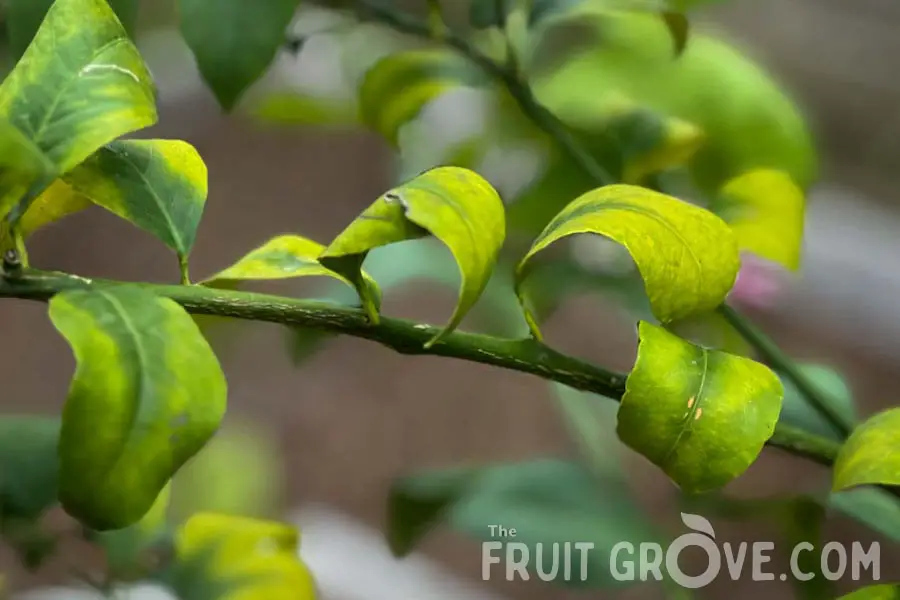
We may receive commissions from purchases made through links in this post, at no additional cost to you.
No matter how conscientious you are as a gardener, there’s always something to improve, isn’t there? One day a while back I was strolling through my garden, taking note of what needed to be done, and I noticed that my lemon tree (above) had some curling leaves. It was time to get into problem-solving mode.
There are a lot of reasons lemon trees might have curling leaves. Thankfully, the leaves of citrus plants are like a signal to the gardener, indicating what may be wrong by how they look. So what does it mean when a lemon tree’s leaves start curling at the tip, or folding, or crinkling up along the edges? And, more importantly, how do you fix it?
The most common reasons for curling lemon tree leaves are drought stress and aphids. Other causes include potassium or magnesium deficiency, thrips, citrus leaf miners, or cold stress. Good cultural practices, such as regular watering, fertilizing, pruning, and natural pest treatments can help control leaf curl.
Citrus leaf curl is not a disorder in itself (like peach leaf curl), but is a symptom of some underlying problem. In this article, I’ve included photos and details describing the appearance of the leaves for each possible cause. Read on to see how to identify the cause of lemon leaf curl, and for practical solutions to remedy the problem.
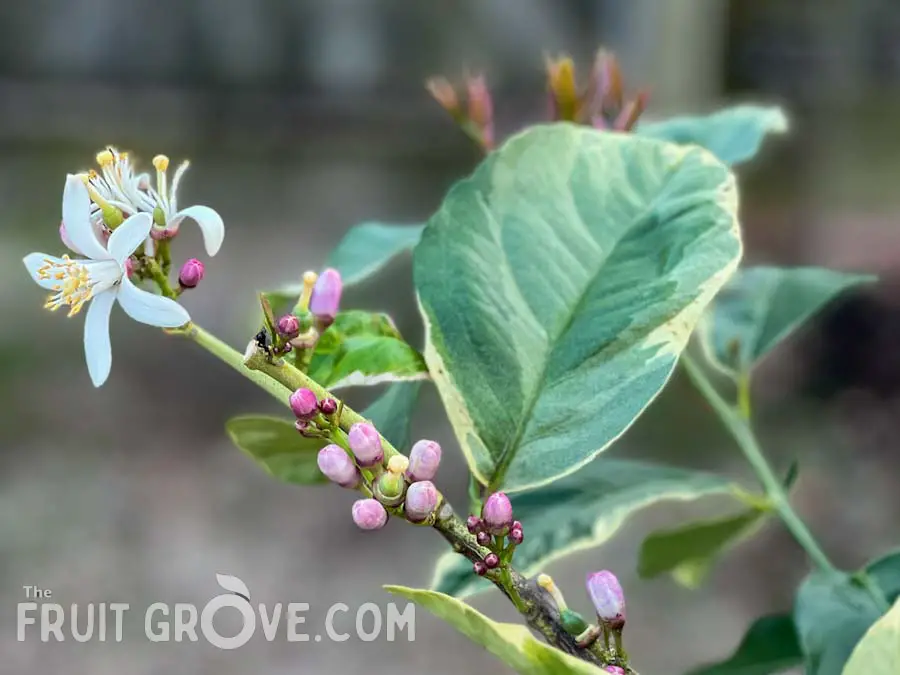
6 Reasons for Leaf Curl on Lemon Trees
The first step is to identify exactly what the leaves look like in order to determine what’s causing the curling. Check the list below (and accompanying pictures) for what fits your situation.
The most likely culprits are drought stress, aphids, and certain nutrient deficiencies, but other environmental and pest factors could also cause curling leaves. Luckily, most of these issues are simple to fix.
1. Drought Stress
A lack of moisture is very likely to cause lemon tree leaves to curl. This may be due to under-watering, too-shallow irrigation, wind stress, excessive heat, or other inconsistent watering practices.
What Drought-Stressed Lemon Leaves Look Like
A lemon tree that’s suffering from drought stress will have leaves that curl longitudinally, from the side edges inward. This is also called a “cigar curl” because the leaves resemble rolled-up cigars. The leaves may also turn a duller green color. If the dehydration continues, the leaves will turn brown and crisp, then fall off.
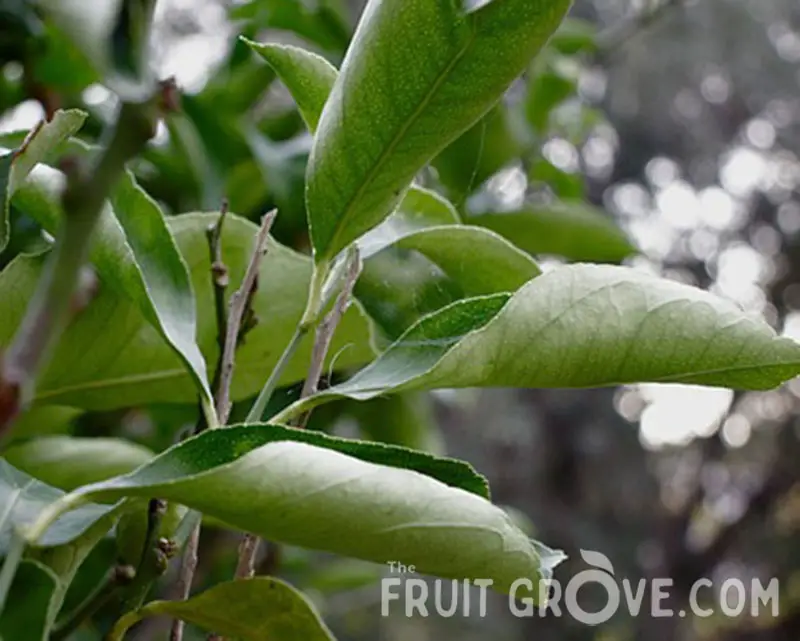
How to Fix It
For lemon trees planted in the ground, water when the top few inches of the soil are dry. It’s best to water deeply at less frequent intervals, rather than shallow watering more often. Use a soaker hose or drip irrigation for the most control in watering the tree.
You can also simply turn on a regular hose to a trickle, then place it near the dripline of the tree and let the water run for 30 minutes to an hour. (It may be a good idea to move the hose once or twice around the tree to soak the whole root area).
For potted lemon trees, increase the frequency and depth of watering. I typically stick my finger in the soil, and if it’s dry to about the second knuckle I know it’s time to water. During the heat of summer, you may need to water once or twice a day, depending on the climate and the size of the pot. Water a potted lemon tree until you see water coming out of the bottom of the pot.
Learn more: Watering Lemon Trees: How to Get it Just Right
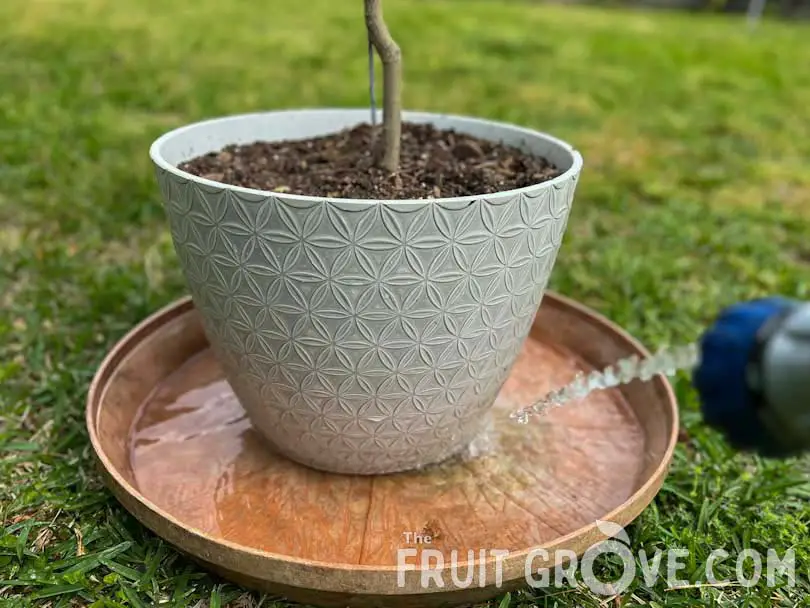
You can also water a potted tree from below. Place the pot in a large plant saucer or other container. Add water to the container, and let the tree soak it up for about 30 minutes, or until the soil feels moist. Be sure to dump out the excess water in the dish to prevent over-watering. This method allows the entire root ball to absorb moisture, rather than just the top few inches.
Water a potted lemon tree with room temperature or tepid water, since cold water may shock the roots and cause the leaves to curl more. This is especially important for trees that are grown indoors since they aren’t used to temperature fluctuations. You can also mist the leaves of indoor trees with water for an extra boost of moisture.
NOTE: Although over-watering can certainly be a problem with lemon trees, it doesn’t typically cause leaf curl. Too much water will cause leaves to turn yellow, droop, then turn brown and fall off. Overwatering can also cause root rot, eventually killing the tree.
Correcting the watering problem will likely make the newer curling leaves unfurl. Older leaves (ones that are darker, thicker, and lower on the plant) may keep their curled shape even after the water issue is solved since they are less supple than young leaves.
I like to put a few inches of compost or mulch on top of my potted lemon trees. This insulates the roots from extreme heat or cold, and it also prevents excessive evaporation. The compost or mulch will break down over time, providing some nutrition for the tree, too.
Related: Is Your Citrus Tree Overwatered or Underwatered?
2. Aphids
Aphids are a pretty common issue with lemon trees because most lemon varieties send out flushes of new growth throughout the season (especially in warm climates). These tiny black or brown insects love the tender new foliage, but as the leaves mature and harden they lose interest.
If you aren’t sure whether you have an aphid problem, also check for ants. Ants protect aphids, essentially cultivating them so they produce the sweet, sticky honeydew that ants love. Ants will move aphids around a plant and help them get to the tender green growth.
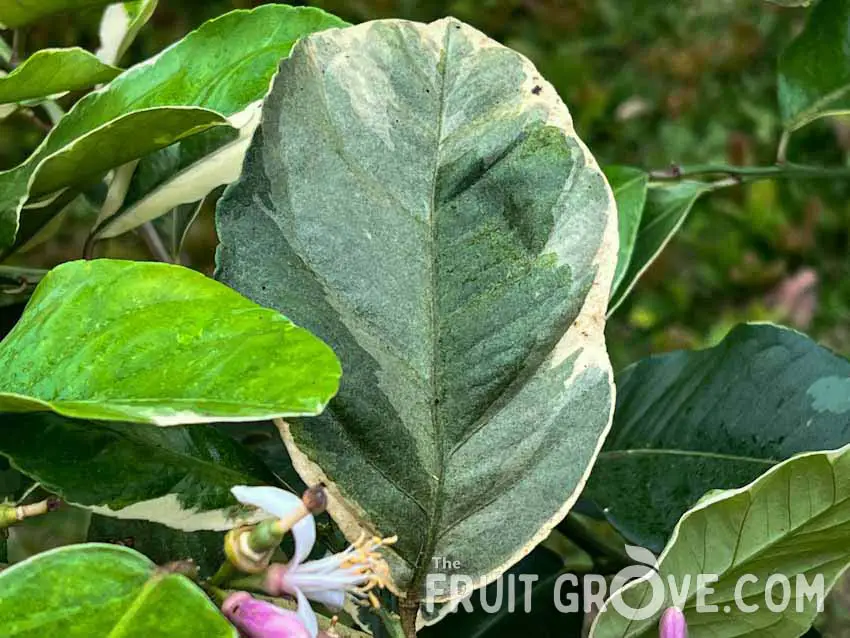
You may also notice a black, sooty substance on leaves affected by aphids. This is a black, powdery fungus that grows because of the honeydew residue left on leaves by those pesky aphids. This sooty mold doesn’t actually infect the tree, but its growth could inhibit light from reaching the surface of the leaves.
What Aphid-Damaged Lemon Leaves Look Like
Aphid damage on young leaves makes them look cupped or distorted, eventually becoming sticky. There may also be black sooty mold on the surface of older leaves.
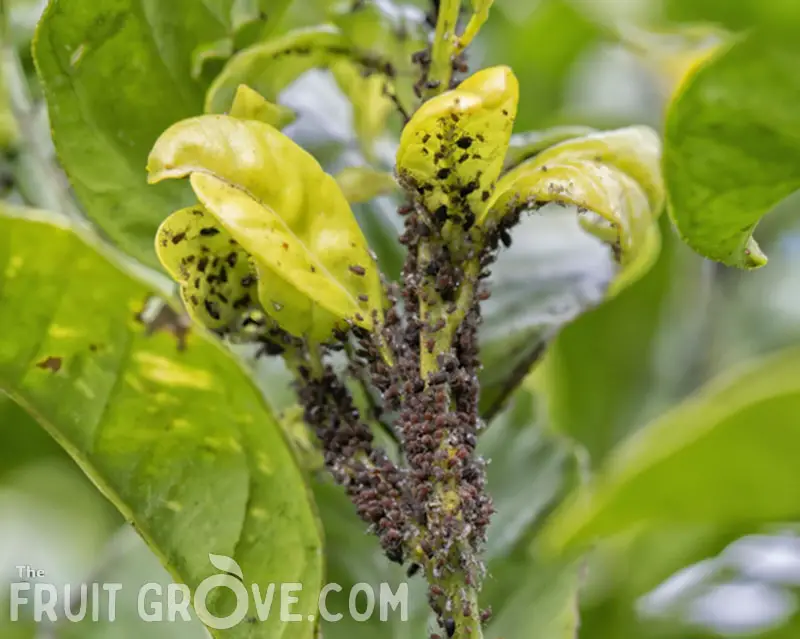
How to Fix It
For a mild aphid infestation, simply hosing the insects off with a strong stream of water may be enough to control the problem. You will probably have to come back and repeat this every several days, however, or the aphids will return.
Apply insecticidal soap or neem oil every week to eliminate or prevent an aphid infestation. Be sure to thoroughly coat the entire plant, including the underside of the leaves (where aphids love to hide). When in doubt, follow the instructions on the back of the bottle. To protect pollinating insects, avoid these sprays when the tree is in blossom.
You can also easily make your own insecticidal soap spray: In a 1-quart spray bottle, combine 1/4 cup of vegetable oil and 1 tablespoon of mild dish soap (stay away from anything labeled “Ultra”). Fill the rest of the bottle up with water, screw on the lid, then shake gently to combine.
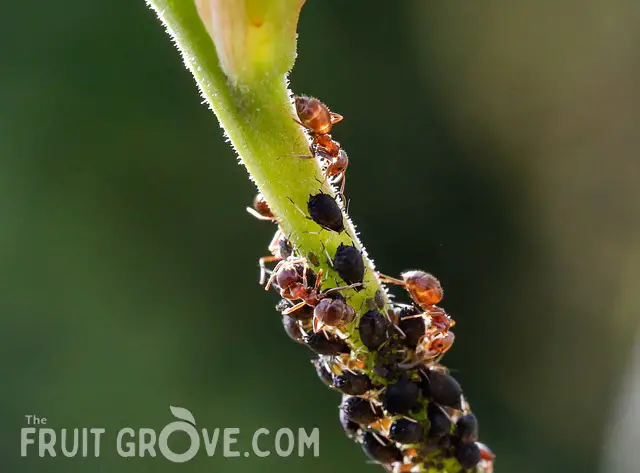
If you have aphids on your lemon tree, you probably have an ant problem, too. Aphids attract ants, and ants protect aphids. Try setting ant baits near the tree to keep the ants away. Find a simple recipe for a homemade sugar and borax ant bait here.
3. Potassium or Magnesium Deficiency
Potted lemon trees, in particular, are susceptible to nutrient deficiencies. There is limited soil in a potted environment, which means limited nutrients available to the plant. Deficiencies of nitrogen, iron, and other elements can cause various discolorations of lemon tree leaves. But if you notice leaves that are yellow and curling, chances are it’s due to a lack of potassium or magnesium.
Potassium is one of the macronutrients necessary for the health of many plants (along with nitrogen, phosphorus, and a few others). In citrus trees, it helps with fruit formation and enhances the color, flavor, and size of the fruit. Potassium is also essential in helping the tree tolerate environmental stress, such as extreme temperatures, flooding, or drought.
Magnesium is secondary macronutrient, meaning it is needed in somewhat smaller quantities. Magnesium is essential for photosynthesis and is a part of chlorophyll molecules (the stuff that makes plants green).
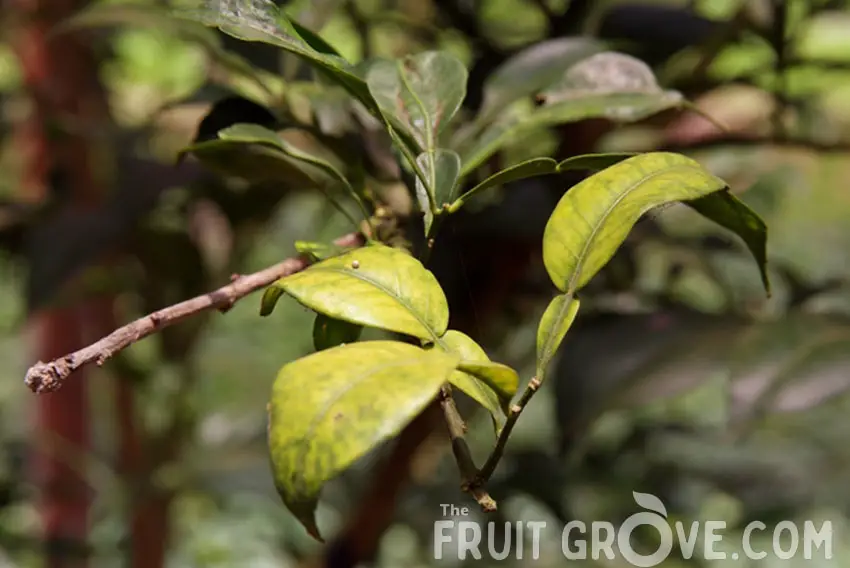
What Potassium- and Magnesium-Deficient Lemon Leaves Look Like
Symptoms of potassium deficiency in lemon trees include leaves that are yellowed (called chlorosis) and curling or folding down at the tip. The affected leaves may appear smaller than usual and look yellow with darker green veining. There may also be necrotic brown spots visible on the leaves (source).
Magnesium deficiency will first appear as yellow blotches on the edges of the leaves on either side of the center rib. The leaves may curl in at the tip and develop a darker green inverted V-shape in the center of the leaf, with the outer portion of the leaf a lighter green or yellow (source).
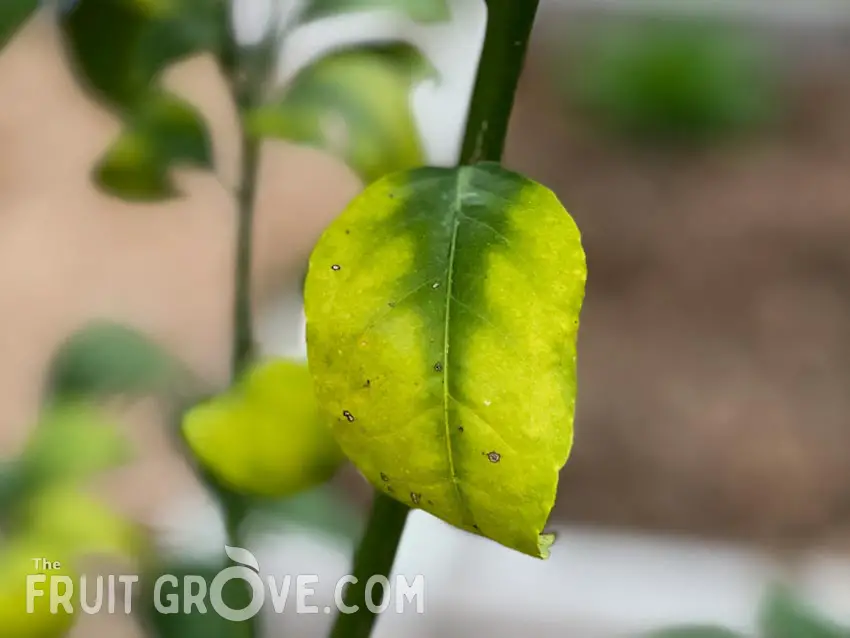
Branches that fruited heavily the previous year will usually show more signs of magnesium deficiency. For both magnesium and potassium issues, symptoms often show first on older mature leaves. Lemon trees tend to prioritize the development of new growth, so the plant will pull nutrients from the older foliage and use it for the young leaves.
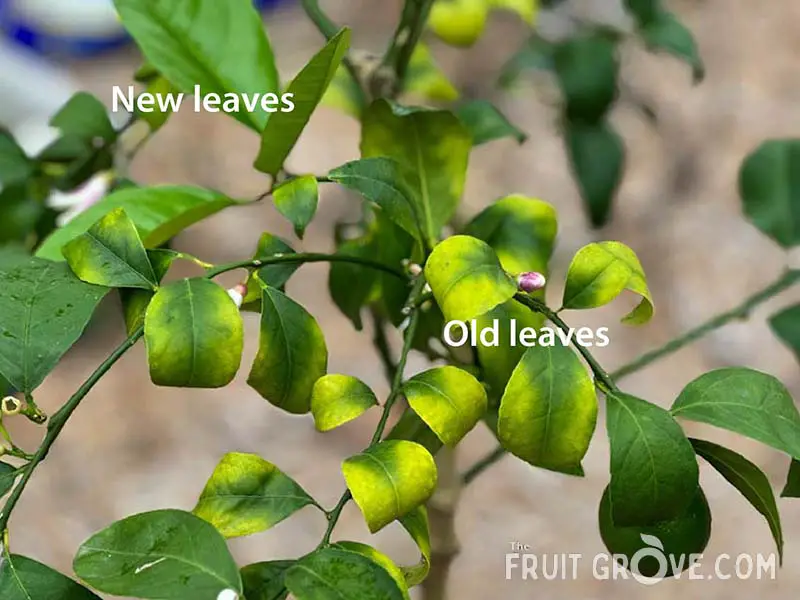
If you see the tips of the leaves curling down and the other symptoms described here, and if you’ve eliminated the possibility of drought stress or aphids, then chances are your lemon tree is lacking potassium or magnesium.
How to Fix It
A regular fertilizing regimen will prevent or fix nutrient deficiencies in lemon trees. I feed my potted lemon trees every two to four weeks during the growing season since frequent watering flushes out nutrients in the soil.
I explain exactly how to feed potted lemon trees in my article: Fertilizing Potted Lemon Trees: Everything you NEED to Know.
To fix a lack of potassium in a potted tree, use an organic soluble fertilizer such as Miracle-Gro Performance Organics All Purpose fertilizer. I’ve been using this one for my potted citrus trees lately, and I’ve been very happy with the results. It has an NPK ratio of 11-3-8, which means it has a fairly high concentration of potassium (and nitrogen, which is another essential element for lemon trees). It’s also pretty inexpensive and easy to find.
For in-ground lemon trees, use a slow-release, granular organic fertilizer 3 or 4 times per year. I like this Espoma Citrus-tone Citrus and Avocado Food. Its NPK ratio is 5-2-6, which is a higher concentration of potassium. It also contains 0.2% magnesium, along with other micronutrients.
For a dose of magnesium that can be quickly absorbed by the tree, use a foliar spray. Make a solution of Epsom salt (magnesium sulfate) and water in a spray bottle – about 1 tablespoon per gallon of water.
Spray the leaves of the plant thoroughly and repeat monthly if symptoms persist. You can also apply an Epsom salt solution (about 2 tablespoons per gallon of water) directly to the soil.
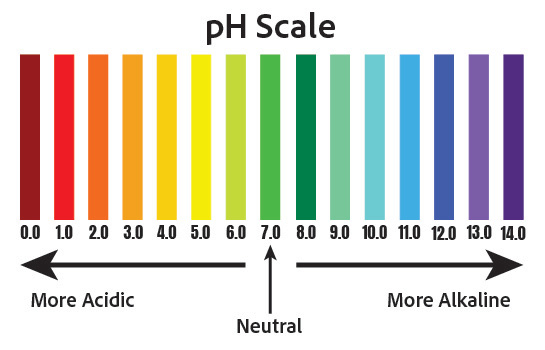
Soil pH is an important factor in how a plant is able to absorb nutrients. Lemon trees prefer a pH of 5.5-6.5, which is slightly acidic. Soil that is too alkaline will prevent the tree from taking up the nutrients it needs. You can use garden lime to raise soil pH, or a sulfur-based soil acidifier to lower pH. For potted lemon trees, replace the potting soil every three years to balance the acidity and reinvigorate the plant.
When in doubt, if you’re not sure if your lemon tree is lacking in a particular nutrient, perform a simple soil test. You can also send out a soil sample to a testing facility – visit this site for a list of soil test labs by state.
4. Cold Stress
Sudden or abnormally cold weather can also cause lemon leaves to curl. If the freeze is mild, the leaves may recover a normal appearance as the weather warms up. A harder freeze will cause foliage to fall off the tree, or completely shrivel and die.
What Cold-Damaged Lemon Leaves Look Like
In cold weather, leaves may simply look curled in or wavy around the edges. A frost-damaged young lemon leaf may first look normal, but then develop dark green damp-looking patches or look completely wet and shriveled. Older leaves with frost damage will turn partially or completely light brown and bleached-looking.
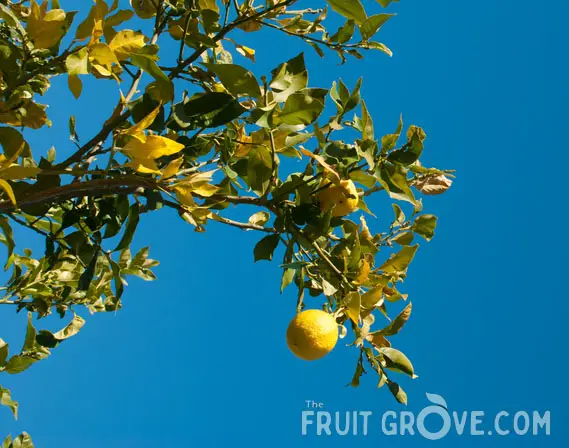
How to Fix It
If the cold is relatively mild, the curled-in leaves will probably unfurl as the weather rewarms. Mild cold stress shouldn’t cause any lasting damage.
If the leaves are more severely frost damaged, they may fall off the tree. This doesn’t necessarily mean the tree or branch has died. Often, leaf fall is an indicator that the wood is still okay and the tree will put out new leaves in spring.
Leaves that turn brown and crisp but stay on the branch may indicate that the branch (or the whole tree) has died. Lightly scratch the surface bark of the branch to see if the interior is light green (still alive) or brown (dead).
Slow down on fertilizing as your tree is recovering from freeze damage. Once the canopy has returned to how it was before the freeze, you can resume a regular fertilizing regimen.
I live in a very warm climate (USDA zone 8b), but even in my area I have to protect my lemon trees from cold temperatures. If you are worried about potential cold damage, plant your citrus trees in pots. Then it’s easy to carry or wheel them into a protected location over the winter – like a garage, shed, or indoors.
5. Citrus Leafminers
Citrus leafminers are tiny moths whose larvae feed by tunneling through young citrus leaves. In addition to creating unsightly brown lines and leaf distortion, leaves affected by these pests can become susceptible to other damage from wind or insects.
Older, hardened-off leaves are usually not affected by citrus leafminers. Mature trees can typically sustain some damage from these pests without it affecting the crop or overall tree health.
What the Leaves Look Like
Leaves damaged by citrus leafminers will have visible tan or brown trailing tunnel lines on the top or underside of young leaves. The foliage may appear distorted or cupped in shape. Citrus miners only feed on new, tender growth, unless the infestation is very severe.
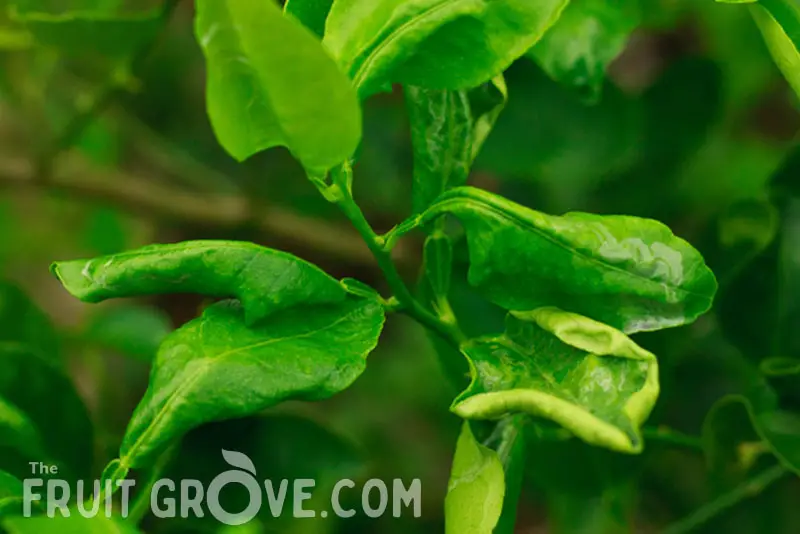
How to Fix It
On mature trees, leafminer damage is unlikely to cause any lasting problems or affect the lemon crop at all. These pests are rarely fatal to a tree, even very young trees. In many cases, the best way to get rid of leafminers is to wait and let nature take care of the problem for you.
Citrus miners are naturally controlled by parasitic wasps in most locations, so you may not need to do anything. Avoid applying any broad-spectrum insecticides because they may actually harm the predatory insects, compounding the leafminer problem.
Hot summer weather tends to diminish leafminer issues. You don’t need to remove any affected leaves, since they can still photosynthesize for the plant.
Do major pruning only once a year, in early spring. Pruning signals the plant to send out a lot of new growth, which is attractive to citrus leafminers. New growth may continue throughout the whole season, but in smaller, slower flushes.
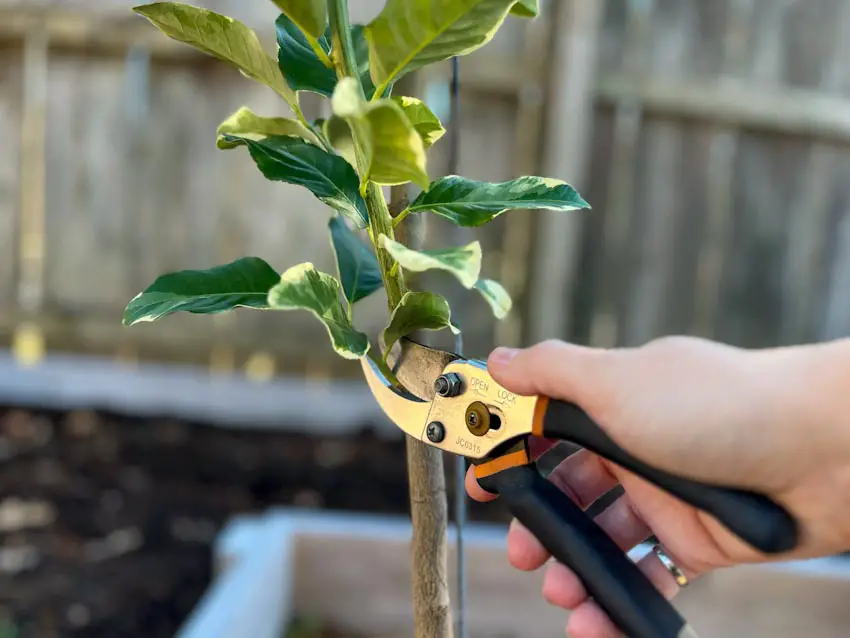
It’s also good to avoid feeding the tree with a high-nitrogen fertilizer if you notice that the leafminer population is high. Nitrogen will cause the plant to increase growth, which will provide plenty of tender leaves for the pests to feed on.
Another good practice is to remove water sprouts and suckers as they show up throughout the season. Citrus leafminers love to lay their eggs along these vigorous shoots.
The University of California Integrated Pest Management Program has a great resource on managing citrus leafminer issues.
6. Thrips
These are tiny, yellow-orange insects whose larvae feed on young leaves and fruit of citrus trees. Adult thrips lay their eggs throughout the spring, summer, or fall. The eggs can overwinter on a plant and hatch right around the time that vigorous new growth starts – just in time to feed.
What the Leaves Look Like
Thrips only feed on new leaves, which can become curly or distorted and thickened in appearance. There may also be gray streaks near the vein of the leaf (source). Most thrip damage is seen on the rind of developing fruit, which may have a silvery “ring scar” near the stem end.
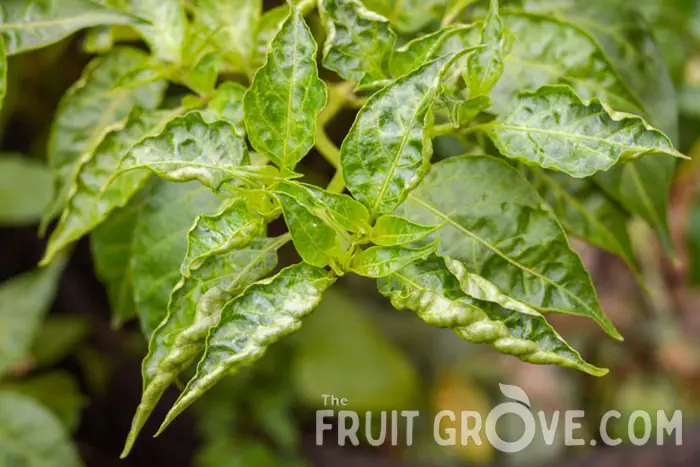
How to Fix It
Thankfully, thrip damage is typically only cosmetic to the young leaves and fruit. There are some natural predators that will help control the thrip population most of the time.
Avoid the use of pesticides in trying to control thrips. In commercial orchards, citrus thrips tend to be more of a problem in groves with a higher use of broad-spectrum insecticides. Thrips are also notorious for developing resistance to different chemicals.
Your best bet is to keep your lemon tree as happy and healthy as possible. A healthy tree will be able to easily withstand some damage from thrips or other pests.
Less Likely Reasons for Curling Leaves on a Lemon Tree
Other online sources may cite more reasons for leaves curling on lemon trees, but in my research and experience, these are unlikely to be the culprit. The following issues are less likely to cause curling leaves, but they could still cause problems for your lemon tree.
- Spider mites – This is a particular problem for citrus trees that live indoors. Citrus trees prefer a humid environment, and the drier indoor air makes the environment perfect for spider mites. You may notice tiny insects and white or gray webbing on the plant, but it is unlikely to cause leaf curl.
- Nitrogen or iron deficiency – Nutrient deficiencies are definitely issues that can crop up for lemon trees. A lack of nitrogen or iron is more commonly associated with yellowing or other discoloration of leaves, but not usually curling.
- Overwatering – Too much water may cause lemon tree foliage to droop, turn yellow or brown, or fall off and die. Overwatering does not typically cause curling of the leaves.
- Citrus mites, whitefly, scale insects, citrus canker – These other pests and diseases may cause various issues with lemon trees, but to the best of my knowledge and research, they rarely cause leaf curling.

